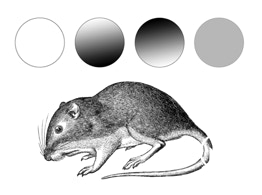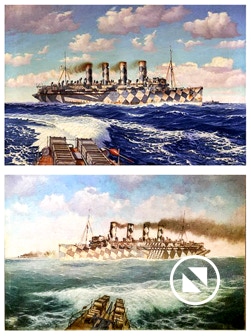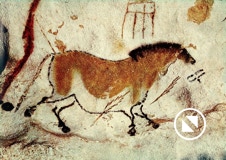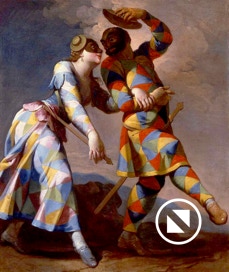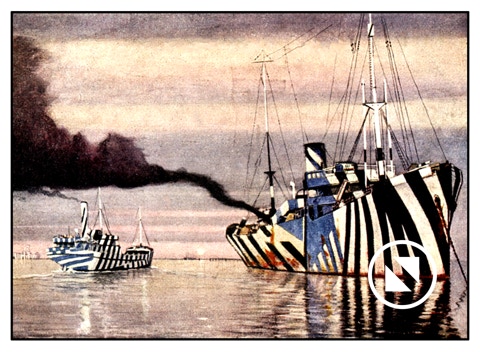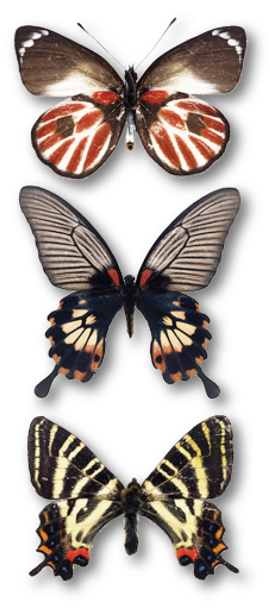
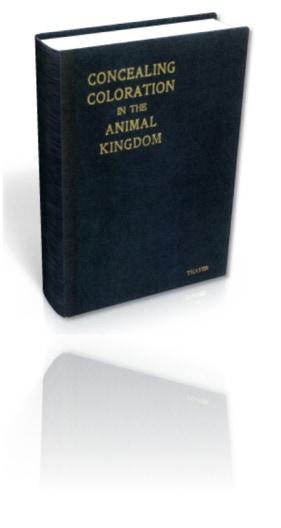
Shown above is the cover of Abbott H. Thayer’s Concealing Coloration in the Animal Kingdom (1909). In earlier published essays, he had announced his discovery of the protective function of “the white undersides of animals,” which he called countershading (upside-down shading, the inverse of what is known today as a “drop shadow”). Countershading cancels out the shading produced by the overhead sun, reducing the rotund or solid appearance of the animal.
The earliest artistic portrayal of countershading may be this painting called “the Chinese horse” (made 20,000 years ago) on the walls of the caves at Lascaux, near Montignac, France.
When dazzle camouflage was adopted in 1917, it was initially recommended that no two ships should wear the same camouflage design, and that the two sides of any ship should be substantially different. In this pair of paintings by Burnell Poole (c1918) one can see the differing dazzle schemes on the starboard and port sides of the HMS Mauretania.
Above (top) is The Three Masked Musicians by Pablo Picasso (1921), and below that is Harlequin with Guitar by Juan Gris (1919). The tactics of Cubism, wrote art historian Wylie Sypher (in Rococo to Cubism in Art and Literature) are the same as those of camouflage: “…a breaking of contours, the passage, so that form merges with the space about it or with other forms, planes or tones that bleed into other planes and tones; outlines that coincide with other outlines, then suddenly reappear in new relations; surfaces that simultaneously recede and advance in relation to other surfaces; parts of objects shifted away, displaced, or changed in tone until forms disappear behind themselves.”
Anon, “Cubism in War” in the New York Tribune, Sunday, September 15, 1918, p. 6—
“Baffle painting is the latest development of marine camouflage, the idea being not to make the ship invisible, but to break up all accepted forms of a ship by masses of strong contrasting colors, distorting her appearance so as to destroy her general symmetry and bulk, the result being to keep the U-boats guessing as to whether she is ‘going or coming.’ A practical use has been found for Cubism, after all.”
Georges Braque, in Alexander Liberman, The Artist in His Studio—
“I was happy when, in 1914, I realized that the Army had used the principles of my Cubist paintings for camouflage. ‘Cubism and camouflage,’ I once said to someone. He answered that it was all a coincidence. ‘No, no,’ I said, ‘it is you who are wrong. Before Cubism we had Impressionism, and the Army used pale blue uniforms, horizon blue, atmospheric camouflage.’”
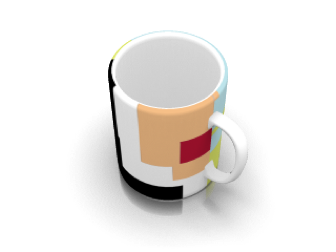
Giovanni Domenico Ferretti, Harlequin and His Lady (18th century).
Sir Alister Hardy The Living Stream: A Restatement of Evolution Theory and its Relationship to the Spirit of Man. New York: Harper and Row, 1965—
“I think it likely that there are no finer galleries of abstract art than the cabinet drawers of the tropical butterfly collector. Each “work” is a symbol, if I must not say of emotion, then of vivid life…It is often, I believe, the fascination of this abstract color and design, as much as an interest in biology or a love of nature, that allures the ardent lepidopterist, although all these may be combined; he has his favorite genera and dotes upon his different species of Vanessa and Parnassius, as the modernist does upon his examples of Matisse or Ben Nicholson. The one-time schoolboy collector will in later life be transfixed with emotion for a moment at the sight of a Camberwell Beauty or a swallowtail—I speak from experience.”
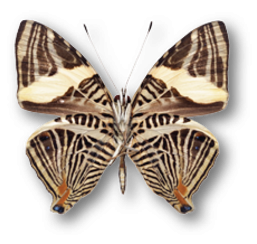
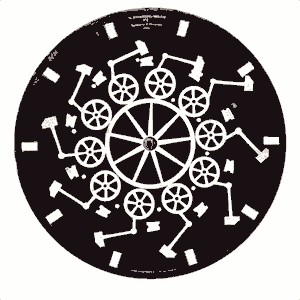
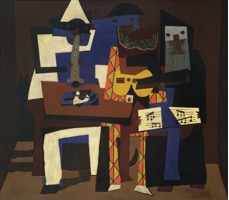
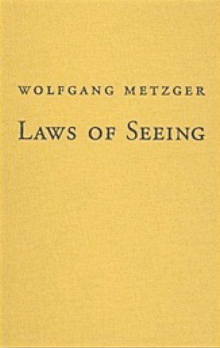
an essay by
an essay published initially in
Gestalt Theory: Journal of the GTA, Vol 20 No 2 (1998), pp. 109-118. Copyright © by Roy R. Behrens.
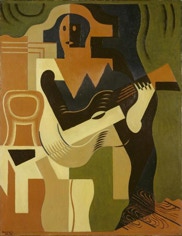
On Max Wertheimer and Pablo Picasso
Gestalt Theory, Cubism and Camouflage
Click on image to enlarge
In 1973, Fritz Heider, a Viennese-born American psychologist, published a memoir on "Gestalt Theory: Early History and Reminiscences" (Heider 1973, 71). Near the end of the article, Heider talks briefly about Gestalt psychologist Max Wertheimer's research of "unit-forming factors" (or perceptual grouping tendencies) and the explicit use of comparable strategies, during roughly the same time period, in the Cubist paintings of Pablo Picasso.
Wertheimer and Picasso were contemporaries: The former, who co-founded Gestalt theory with Kurt Koffka and Wolfgang Köhler, was born in 1880; while the Spanish painter, who invented Cubism with Georges Braque, was born in 1881. Both Gestalt theory and Cubism emerged in the years that preceded World War I. Heider does not suggest that Wertheimer and Picasso were acquainted, or even that they knew about each other's discoveries, but only that "the perceptual phenomena with which they were dealing were the same" (Heider 1973, 71). However, it also seems likely, as he points out, that both realized that the factors that they were exploring were used in military camouflage.
The wartime use of camouflage is hardly a modern invention, but its importance was magnified during World War I in response to long-range artillery, combined with the use of the airplane, wireless telegraphy and aerial photography for battlefield surveillance. It was the French who coined the word "camouflage" and established in 1915 the first section de camouflage in military history. Organized and commanded by an artist, this unit was largely made up of camoufleurs who in civilian life had been artists of one kind or another (Kahn 1984). Soon after, comparable units were formed by the British, the Americans, and, to a lesser extent, by the Italian, Russian, and German armies, with the result that, during both World Wars, literally hundreds of artists were used as wartime camouflage experts (Behrens 1991, 1996, 2002).
That art and camouflage are related was anticipated in the 1890s by Abbott H. Thayer, an American painter with a lifelong interest in natural history. It was Thayer who discovered countershading, a variant of natural camouflage in which the upper surfaces of an animal's body are colored darker, the undersides lighter. Many animals are countershaded (rabbits, squirrels, chipmunks, certain birds, and so on), particularly those that are active during daylight and respond to intrusion by remaining motionless.
Countershading, Thayer noticed, is the inverse of shading, by which artists create the appearance of solidity or three-dimensional volume on a flat surface by coloring shapes darker on the underside and progressively lighter toward the top. When a countershaded animal is observed in the wild, its white undersides counteract the effects of the overhead sun. It is colored darkest on those parts of the body that are most exposed to sunlight, and lightest on those that are mostly in shade. As a result, it appears flat and insubstantial, making it less visible as a solid, three-dimensional "thing."
Emboldened by his discovery, Thayer's interest in protective coloration intensified. He published a series of articles in scientific journals, and collaborated with his son, Gerald H. Thayer, on a large, lavishly-illustrated volume titled Concealing Coloration in the Animal Kingdom: An Exposition of the Laws of Disguise Through Color and Pattern: Being a Summary of Abbott H. Thayer’s Discoveries (Thayer 1909). The book was immediately controversial, not because of countershading (which was readily accepted), but because of the self-assured, arrogant tone with which he presented other less convincing ideas.
At the time, for example, it was generally assumed (as it still is) that certain animal coloration is protective, that it contributes to low visibility, through countershading, figure-ground blending, and mimicry; while other examples of coloration are not protective, but designed to be quickly and easily seen, to assist in the process of finding a mate, deceiving quarry, or intimidating a predator. Thayer disagreed: Without exception, he insisted that all animal coloration, even the most brightly colored patterns, contributes to concealment, and whenever a creature is readily seen, it is simply because it is being observed out of context—outside of its typical natural setting—or from the viewpoint of human observers rather than that of its usual predators.
While Thayer acknowledged the importance of figure-ground blending, he was one of the first to point out that monochromatic coloring is often less effective as concealing coloration, particularly if it lacks countershading, than is high contrast parti-coloring, which he called "razzle-dazzle" or "ruptive" coloring, in which the figure is broken apart visually by "the employment of strong arbitrary patterns of color [which] tend to conceal the wearer by destroying his apparent continuity of surface" (Anderson 1982, 116). Even the conspicuous white tail and patches on the rear end of a pronghorn buck, Thayer argued, are protective markings, because, observed from a crouching position (the viewpoint of its predators), the rump is a jumbled confusion of shapes that blends in with the sky in the background.
As early as 1898, during the Spanish-American War, Thayer advised that countershading should be applied to US warships, using "the general coloring of a seagull, worked in two shades of gray and pure white, the underpart of everything being painted white. The side surfaces were gray, the upper surfaces a slate color resembling the dark back of a seagull" (Bowditch 1970, 151-152). Later, during World War I, he advised the British War Office to replace its khaki field service uniform (first adopted in 1848 in India because of its general resemblance to dust) with a high contrast parti-colored uniform—like the erratic patterns on a harlequin’s costume—so that soldiers, like pronghorn bucks, would appear confusing.
Thayer's influence on military camouflage was substantial, if nearly always indirect. Early in World War I, he was told that the German, British, and French armies had consulted his book in developing their field camouflage; and, in 1917, when America entered the war, one of the co-founders of the American Camouflage Corps was his cousin and former student, the artist Barry Faulkner. In the same year, abstract irregular shapes were applied to thousands of Allied ships as a deterrent to torpedo attacks by German submarines. Developed by British artist Norman Wilkinson (who denied any influence from Thayer) and officially called "dazzle-painting," this kind of high contrast parti-colored camouflage made it difficult to determine the exact course of a distant ship through a periscope (Behrens 1991, 1996).
In his remarks about Wertheimer and Picasso, Heider contends that the Gestalt psychologists "were of course conscious of the fact that camouflage makes use of unit-forming factors, and there was a rumor that Wertheimer or Koffka helped in improving it" (Heider 1973, 71). But he does not mention Thayer's book, nor does he refer to an article on "Protective Coloration in the Light of Gestalt Theory" by Angeline Myra Keen (Keen 1932).
In Keen's brief paper, she compares statements by Thayer about camouflage with excerpts from the writings of Wertheimer's colleagues, Koffka and Köhler. She finds it surprising "that Thayer’s account, written from the standpoint of the artist, parallels so closely, in the field of figure and ground perception, the conclusions drawn after prolonged, careful experimentation by such Gestalt psychologists as Rubin, Köhler, Koffka, and Helson" (Keen 1932, 202). Like Heider, she does not suggest that Gestalt theory is derivative, but expresses astonishment that Thayer, working in advance of Gestalt theory and with the training of an artist, "enunciated a principle which is basically very like the findings of the Gestalter's laboratory—an unexpected confirmation of the Gestalt doctrine" (Keen 1932, 202).
The relatedness of Gestalt theory and camouflage is suggested in other sources as well. For example, G.W. Hartmann contends that Kurt Lewin, who later applied Gestalt theory to social psychology, was a captain in the German infantry in World War I, during which "he maintained sufficient composure to prepare a unique article on the figure-ground phenomena present in the camouflaged scenery of trench warfare!" (Hartmann 1935, 202).1
In Köhler’s book on Gestalt Psychology, he describes camouflage as "a difficult art," and alludes to the combined use by camoufleurs of blending (unit-forming) with disruption (unit-breaking) in a passage in which he refers to the fact that "In modern wars it has become a real art to make objects such as guns, cars, boats, etc., disappear by painting upon these things irregular designs, the parts of which are likely to form units with parts of their environment" (Kohler 1947, 92-93). Koffka cites a comparable example in Principles of Gestalt Psychology, noting that "If a gun is covered with paint in such a way that one part of it will 'fuse' with the bole of a tree, another with leaves, a third with the ground, then the beholder will no longer see a unit, the gun, but a multiplicity of much less important objects" (Koffka 1935, 77).
Superb examples of camouflage are found in Gestaltist Kurt Gottschaldt's experiments with embedded figures, sometimes called "camouflaged figures," which consist of complex arrangements of lines in which smaller, simpler shapes have been hidden (Gottschaldt 1939).
Of all the Gestalt psychologists, none wrote more extensively about camouflage than Wolfgang Metzger in Gesetze des Sehens (Metzger 1975). At the end of World War II, he was visited in Germany by American psychologist Heinz Ansbacher, "who was conducting a survey of German psychology on assignment with the occupation forces. As Ansbacher later reported, Metzger told him his specialty was 'the psychology of perception as applied to camouflage problems'" (Ash 1995, 385).
It was a disruptively-painted gun that introduced Picasso to military camouflage. As Heider points out, we know this because of a famous account in Gertrude Stein's autobiography, cleverly disguised as The Autobiography of Alice B. Toklas (Stein 1962, Behrens 2005). Toklas was the American writer's friend and companion. Stein's autobiography, which is the story of their life together, was written by Stein in the pretended voice of Toklas.
In that book, Stein recalls an evening in the early months of World War I, when she and Toklas, accompanied by Picasso and his mistress Eva Gouel, were strolling and talking in Paris on the Boulevard Raspail: "All of a sudden down the street came some big cannon, the first any of us had seen painted, that is camouflaged. Picasso stopped, he was spellbound. C'est nous qui avons fait ca, he said, it is we that have created that. And he was right, he had. From Cézanne through him they had come to that" (Stein 1962, 84-85).
Stein does not describe the camouflaged cannons, but very likely they were disrupted by abstract irregular shapes, albeit they may have been painted in gray. On February 7, 1915, Picasso wrote the following to his friend Guillaume Apollinaire, the poet and critic, who was then in the French army: "I'm going to give you a very good tip for the artillery. Even when painted gray, artillery and cannons are visible to airplanes because they retain their shape. Instead they should be painted very bright colors, bits of red, yellow, green, blue, white like a harlequin" (Richardson 1996, 349).
A few months later, the poet Jean Cocteau appeared at Picasso's studio wearing a harlequin's costume beneath a raincoat. He asked Picasso to paint his portrait dressed as a harlequin, but the painter declined. Instead, Cocteau left the suit with Picasso, who was delighted by the gift and said jokingly that the French army should issue harlequin outfits to the entire infantry, since the diamonds would make them confusing to see. (Related to this, the following cryptic notation appears in Heider's notebooks: "The figural joke: the clown's costume, one leg red, the other blue, violating symmetry, orderly arrangement, coinciding unit formation (cf. camouflage, the breaking up)" (Benesh-Weiner 1988, 255).)
Georges Braque, the co-founder of cubism, was not in Paris on the night that the camouflaged cannons were seen. He and Picasso were no longer close friends, and Braque was in the French infantry. Long after the war, however, he mentioned in an interview that he had been happy "when, in 1914, I realized that the Army had used the principles of my cubist painting for camouflage. 'Cubism and camouflage,' I once said to someone. He answered that it was all a coincidence. 'No, no,' I said, 'it is you who are wrong. Before cubism we had impressionism, and the Army used pale blue uniforms, horizon blue, atmospheric camouflage'" (Libermann 1969, 143).
From 1915 onwards, parti-colored harlequins occur frequently in Picasso's cubist paintings, of which the most famous examples may be The Three Musicians and The Three Masked Musicians. This pair of paintings was completed in 1921, two years in advance of Wertheimer's seminal paper about "Laws of Organization in Perceptual Forms." Nicknamed "the dot essay" because it was illustrated by abstract patterns of dots and lines, that paper concluded that certain Gestalts are enhanced by our innate tendencies to constellate or to see as "belonging together" elements that look alike (similarity grouping), are close together (proximity grouping), or line up with each other in space (continuity or edge alignment).
The interplay of such unit-forming factors is far from simple, because (1) the appearance of parts is influenced by wholes; (2) judgments about similarity or proximity are always comparative; and, (3) in configurations as intricate as works of art—and in most examples of camouflage—parts may be purposely made to connect by one grouping tendency (similarity of color, for example) but to disconnect by others (differences of size, shape, texture, direction, and so on). "If one looks at these pictures [such as The Three Musicians] after having read Wertheimer's paper," writes Heider, "one realizes immediately that Picasso's new technique [i.e., Cubism] consisted partly in destroying the natural units of familiar objects by opposing one unit-forming factor to another. One specific part of the picture may make a good unit with a table according to one factor, but according to another factor it belongs to the wall" (Heider 1973, 71).
Obviously, the use of unit-forming factors in art did not originate with Cubism. Thayer's "laws of disguise" are approximate parallels to Wertheimer's "laws of organization"; and as demonstrated by Rudolf Arnheim, the art theorist and psychologist who was Wertheimer's student at the Psychological Institute at the University of Berlin, artists throughout history have made at least tacit intuitive use of the tendencies that underlie Gestalt theory (Arnheim 1974). "True enough," agrees Heider, "unit-forming factors were used in older pictures, but more often they were used to help in a redundant way to segregate one object unit from others, e.g., a person from the landscape. One has the feeling that Picasso's introduction of these strange visual contradictions implies a more conscious use of these factors" (Heider 1973, 71).
Abbott H. Thayer died in 1921. In his own way, he was a tireless innovator, but he was schooled in the French Academy and probably had little if any respect for the radical experiments of the Cubists. If he knew about Gestalt theory, it is unlikely that it concerned him. "As a matter of fact," writes Keen (1932, 202), "he was entirely uninterested in the psychological aspects of his discovery…"
At some point, perhaps during or after World War I, the Gestalt psychologists realized the significance of military camouflage in the study of unit-forming factors. But aside from the rumor that Heider reports, there is no evidence that Wertheimer, Koffka or Köhler contributed to it. In recent years, it has been verified that prominent French camoufleurs during World War I were consciously, willingly influenced by cubist methods ("In order to completely dissimulate things," wrote French artist Lucien Victor Guirand de Scevola, who commanded the first camouflage unit, "I used the same methods the Cubists had used to simulate objects" (Kahn 1984, 19).) But the same cannot be said of Gestalt theory and cubism. As Heider concludes, "this tenuous contact [between Gestalt theory and cubism] by way of camouflage does not mean there was an influence in either direction as far as Wertheimer and Picasso were concerned. We have to assume two independent developments reaching a culmination at the same time" (Heider 1973, 71).
Footnotes
1. Hartmann's reference is to Lewin (1917).
2. Full-color reproductions of these two paintings by Picasso are found in Pierre Daix (1965), Picasso. New York: Frederick A. Praeger, 112-113.
References
ANDERSON, R. (1982): Abbott Handerson Thayer. Syracuse, New York: Everson Museum.
ARNHEIM, R. (1974): Art and Visual Perception: The New Version. Berkeley: University of California Press.
ASH, M. (1995): Gestalt Psychology in German Culture, 1890-1967. Cambridge, England: Cambridge University Press.
BEHRENS, R.R. (1991): Blend and Dazzle: The Art of Camouflage. Print, 45, pp. 92-98ff.
BEHRENS, R.R. (1996): “Camouflage.” In J. Turner (ed.), The Dictionary of Art. London & New York: Grove Dictionaries.
BEHRENS, R.R. (2002): False Colors: Art, Design and Modern Camouflage. Dysart, Iowa: Bobolink Books.
BEHRENS, R.R. (2005): Cook Book: Gertrude Stein, William Cook, and Le Corbusier. Dysart, Iowa: Bobolink Books.
BENESH-WEINER, M. (ed.) (1988): The Notebooks / Fritz Heider. Volume 2. Muchen-Weinheim: Psychologie Verlags Union.
BOWDITCH, N. (1970): George de Forest Brush. Peterborough, New Hampshire: William L. Bauhan.
GOTTSCHALDT, K. (1939): “Gestalt Factors and Repetition.” In W.D. Ellis (ed.), A Source Book of Gestalt Psychology (pp. 109-135). New York: Harcourt, Brace & Company.
HARTMANN, G.W. (1935): Gestalt Psychology. New York: Ronald Press.
HEIDER, F. (1973): “Gestalt Theory: Early History and Reminiscences.” In M. Henle, J. Jaynes & J.J. Sullivan (eds.), Historical Conceptions of Psychology (pp. 63-73). New York: Springer.
KAHN, E.L. (1984): The Neglected Majority: "Les Camoufleurs," Art History, and World War I. Lanham, Maryland: University Press of America.
KEEN, A.M. (1932): “Protective Coloration in the Light of Gestalt Theory.” Journal of General Psychology, 6, 200-203.
KOFFKA, K. (1935): Principles of Gestalt Psychology. New York: Harcourt, Brace & World.
KOHLER, W. (1947): Gestalt Psychology. New York: New American Library.
LEWIN, K. (1917): “Kriegslandschaft.” Zeitschrift fur angewandte Psychologie, 12, 440-447.
LIBERMANN, A. (1969): The Artist in His Studio. New York: Viking Press.
METZGER, W. (1975): Gesetze des Sehens. Frankfurt am Main: Verlag Waldemar Kramer.
RICHARDSON, J. & MCCULLY, M. (1996): A Life of Picasso: Volume II: 1907-1917. New York: Random House.
STEIN, G. (1962): The Autobiography of Alice B. Toklas. In C. Van Vechten (ed.), Selected Writings of Gertrude Stein. New York: Random House Modern Library.
THAYER, G.H. (1909): Concealing Coloration in the Animal Kingdom: An Exposition of the Laws of Disguise Through Color and Pattern: Being a Summary of Abbott H. Thayer's Discoveries. New York: Macmillan.
WERTHEIMER, M. (1939): “Laws of Organization in Perceptual Forms.” In W.D. Ellis (ed.), A Source Book of Gestalt Psychology (pp. 71-88). New York: Harcourt, Brace & Company.
•••
John Everett. colored drawing of the SS Lepanto (right) in dazzle camouflage (c1918)
